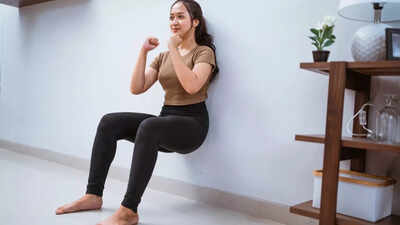ARTICLE AD BOX

High blood pressure, also known as hypertension, is a widespread health issue that can cause serious problems if not controlled. Managing it typically involves lifestyle changes like eating a balanced diet and exercising regularly.
However, some quick exercises can offer immediate benefits. According to a study published in the British Journal of Sports Medicine, one effective and simple exercise is the wall sit, which involves sitting against a wall with your knees bent at a right angle. This move helps improve circulation and strengthen muscles, which can contribute to lowering blood pressure. Incorporating wall sits into your daily routine may provide a fast, accessible way to support heart health.
What is a wall sit and how it helps to lower blood pressure
A wall sit is an isometric exercise where you slide down a wall until your knees are at a 90-degree angle, as if sitting in an invisible chair. This position engages the thigh muscles and requires you to hold the position for a set period.Performing wall sits can lead to a temporary increase in blood pressure due to muscle engagement. However, this is followed by a rebound effect where blood vessels dilate, leading to a decrease in blood pressure.
This process helps improve vascular health over time.
How to perform a wall sit
- Find a wall: Stand with your back against a wall.
- Slide down: Slowly slide your back down the wall until your thighs are parallel to the ground.
- Hold the position: Keep your knees at a 90-degree angle and hold the position for 2 minutes.
- Rest: Stand up slowly and rest for a few minutes.
- Repeat: Aim to perform this exercise 3 times a week for optimal results.
Who should try the wall sit exercise
Wall sits are generally safe for most adults but may not be suitable for those with knee or back problems. It’s best to consult with your healthcare provider before starting any new exercise, especially if you have existing medical conditions or severe hypertension.
Additional tips for managing blood pressure
While wall sits can be beneficial, incorporating other lifestyle changes can further help manage blood pressure:
- Regular exercise: Engage in activities like walking, cycling, or swimming.
- Healthy diet: Focus on a diet rich in fruits, vegetables, and low-fat dairy.
- Limit salt intake: Reduce sodium consumption to help lower blood pressure.
- Manage stress: Practice relaxation techniques such as meditation or deep breathing.
- Regular monitoring: Keep track of your blood pressure readings to monitor progress.
Disclaimer: This article is for informational purposes only and is not a substitute for medical advice. Always consult your doctor before starting any new exercise or making changes to your health routine, especially if you have existing medical conditions.Also read | Colon cancer risk factors: What increases your chances?



.png)
.png)
.png)
















 6 hours ago
5
6 hours ago
5









 English (US) ·
English (US) ·